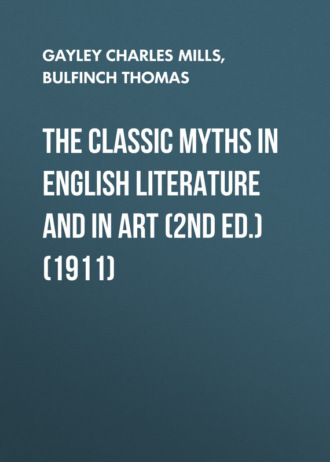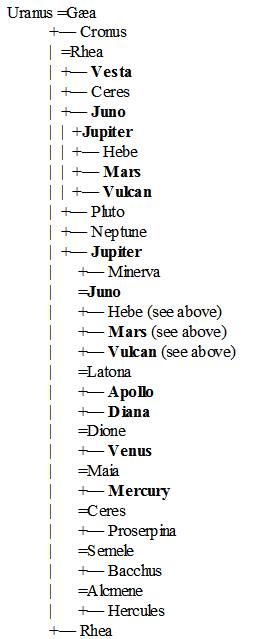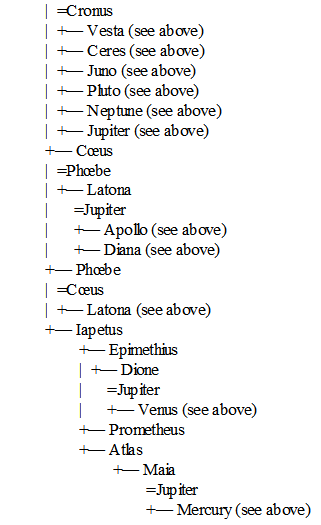 полная версия
полная версияThe Classic Myths in English Literature and in Art (2nd ed.) (1911)
In fine, the materials of the poem would persuade us not only of its origin in very ancient popular lays, but of their fusion and improvement by the imaginative effort of at least one, and probably of several poets, who lived and wrote between 1120 and 1200 A.D. The metrical structure, also, would indicate derivation from the German folk song and modification due to multifarious handling on the part of popular minstrels and poets of written verse.420
302. Records of Oriental Mythology: Egyptian. 421 Although the myths of Egypt, India, and Persia are of intense interest and importance, they have not materially affected English literature. The following is, however, a brief outline of the means by which some of them have been preserved.
The Egyptian records are (1) The Hieroglyphs, or sacred inscriptions in Tombs of the Kings, and other solemn places, – conveying ideas by symbols, by phonetic signs, or by both; (2) The Sacred Papyri, containing hymns to the gods; (3) The Books of the Dead and of the Lower Hemisphere, – devoted to necromantic incantations, prayers for the souls of the departed, and other rituals.
303. Indian Records. (1) The Vedas, or Holy Scriptures of the Hindus, which fall into four divisions. The most ancient, the Rig-Veda, consists of hymns of an elevated and spiritual character composed by families of Rishis, or psalmists, as far back, perhaps, as 3000 B.C., not later than 1400 B.C. They give us the religious conceptions of the Aryans when they crossed the Himalayas and began to push toward Southern Hindustan. The Sama-Veda is a book of solemn chants and tunes. The Yajur-Veda comprises prayers for sacrificial occasions, and interpretations of the same. The Atharva-Veda shows, as might be expected of the youngest of the series, the influence upon the purer Aryan creed of superstitions borrowed, perhaps, from the aboriginal tribes of India. It contains spells for exorcising demons and placating them.
(2) The Indian Epics of classical standing. They are the Mahâbhârata and the Râmâyana. Scholars differ as to the chronological precedence. The Great Feud of the Bhâratas has the air of superior antiquity because of the numerous hands and generations that have contributed to its composition. The Adventures of Râma, on the other hand, recalls a more primitive stage of credulity and of savage invention. The Mahâbhârata is a storehouse of mythical tradition. It contains several well-rounded epic poems, the most beautiful of which is the Episode of Nala, – a prince who, succumbing to a weakness common to his contemporaries, has gambled away his kingdom. The Great Feud of the Bhâratas is, indeed, assigned to an author – but his name, Vyâsa, means simply the Arranger. The Râmâyana purports to have been written by the poet Vâlmîki. It tells how Sita, the wife of Prince Râma, is carried off to Ceylon by Râvana, king of the demons, and how Râma, by the aid of an army of monkeys, bridges the straits between India and Ceylon and, slaying the demon, recovers his lovely and innocent wife. The resemblance between the plot and that of the Iliad has inclined some scholars to derive the Indian from the Greek epic. But, until the relative antiquity of the poems is established, the Iliad might as well be derived from the Râmâyana. The theory is unsubstantiated. These epics of India lack the artistic spirit and grace of the Iliad and the Odyssey, but they display a keener sympathy with nature and a more romantic appreciation of the loves and sorrows of mankind.
304. Persian Records. The Avesta, or Sacred Book of the ancient Persians, composed in the Zend language and later translated into medieval Persian, – or Pahlavi, – contains the Gáthás, or hymns of Zoroaster and his contemporaries, and scriptures of as recent a date as the fifth century B.C. Zoroaster, a holy man of God, was the founder or the reformer of the Persian religion. He lived as early as the fourteenth or fifteenth century B.C., and his system became the dominant religion of Western Asia from the time of Cyrus (550 B.C.) to the conquest of Persia by Alexander the Great. The teachings of Zoroaster are characterized by beautiful simplicity, and by an unwavering faith in the ultimate victory of righteousness (Ormuzd) over evil (Ahriman).
COMMENTARY 422
[It is hoped that this Commentary may be useful to general readers, to students of art, and to teachers in the secondary schools, as well as to pupils. The cross references are always to sections; and the section numbers correspond with those of the text in the body of the book. The letter C. prefixed to a number indicates Commentary.]
3. Chaos: a gap. Compare the "Beginning Gap" of Norse mythology. Eros: a yearning. Erebus: black, from root meaning to cover.
4. Uranus (Greek Ouranos) corresponds with the name of the Indian divinity Varunas, root var, 'to cover.' Uranus is the starry vault that covers the earth; Varunas became the rain-giving sky. Titan: the honorable, powerful; the king; later, the signification was limited to the sun. Oceanus probably means flood. Tethys: the nourisher, nurse. Hyperion: the wanderer on high;423 the sun. Thea: the beautiful, shining; the moon. She is called by Homer Euryphaëssa, the far-shining. Iapetus: the sender, hurler, wounder. Themis: that which is established, law. Mnemosyne: memory. Other Titans were Cœus and Phœbe, figurative of the radiant lights of heaven; Creüs and Eurybië, mighty powers, probably of the sea; Ophion, the great serpent, and Eurynome, the far-ruling, who, according to Apollonius of Rhodes, held sway over the Titans until Cronus cast them into the Ocean, or into Tartarus.
Cronus (Greek Kronos) is, as his name shows, the god of ripening, harvest, maturity. Rhea comes from Asia Minor, and was there worshiped as the Mother Earth, dwelling creative among the mountains. Cronus (Kronos) has been naturally, but wrongly, identified with Chronos, the personification of Time, which, as it brings all things to an end, devours its own offspring; and also with the Latin Saturn, who, as a god of agriculture and harvest, was represented with pruning-knife in hand, and regarded as the lord of an ancient golden age.
The three Cyclopes were Brontes, Steropes, and Arges. Cyclops means the round-eyed. The Hecatonchires were Briareus, the strong, called also Ægæon; Cottus, the striker; Gyes, or Gyges, the vaulter, or crippler. Gyges is called by Horace (Carm. 2, 17, 14) Centimanus, – the hundred-handed.
Illustrative. Milton, in Paradise Lost, 10, 581, refers to the tradition of Ophion and Eurynome, who "had first the rule of high Olympus, thence by Saturn driven." Hyperion: see Shakespeare's Hamlet, "Hyperion's curls, the front of Jove himself." Also Henry V, IV, i; Troilus and Cressida, II, iii; Titus Andronicus, V, iii; Gray, Progress of Poesy, "Hyperion's march they spy, and glittering shafts of war"; Spenser, Prothalamion, "Hot Titans beames." On Oceanus, Ben Jonson, Neptune's Triumph. On Saturn, see Shakespeare, Much Ado About Nothing, I, iii; 2 Henry IV, II, iv; Cymbeline, II, v; Titus Andronicus, II, iii; IV, iii; Milton, Paradise Lost, 1. 512, 519, 583, and Il Penseroso, 24. See Robert Buchanan, Cloudland, "One like a Titan cold," etc.; Keats, Hyperion; B. W. Procter, The Fall of Saturn.
In Art. Helios (Hyperion) rising from the sea: sculpture of eastern pediment of the frieze of the Parthenon (British Museum). Mnemosyne: D. G. Rossetti (crayons and oil).
5. Homer makes Zeus (Jupiter) the oldest of the sons of Cronus; Hesiod makes him the youngest, in accordance with a widespread savage custom which makes the youngest child heir in chief. – Lang, Myth, Ritual, etc., 1, 297. According to other legends Zeus was born in Arcadia, or even in Epirus at Dodona, where was his sacred grove. He was in either case reared by the nymphs of the locality. According to Hesiod, Theog. 730, he was born in a cave of Mount Dicte, in Crete.
6. Atlas, according to other accounts, was not doomed to support the heavens until after his encounter with Perseus.
8. See Milton's Hymn on the Nativity, "Not Typhon huge ending in snaky twine." The monster is also called Typhoeus (Hesiod, Theog. 1137). The name means to smoke, to burn. The monster personifies fiery vapors proceeding from subterranean places. Other famous Giants were Mimas, Polybotes, Ephialtes, Rhœtus, Clytius. See Preller, 1, 60. Briareus (really a Centimanus) is frequently ranked among the giants.
Illustrative. Shakespeare, Troilus and Cressida, I, ii; Milton, Paradise Lost, 1, 199, and Hymn on the Nativity, 226; M. Arnold, Empedocles, Act 2; Pope, Dunciad, 4, 66. For giants, in general, see Milton, Paradise Lost, 3, 464; 11. 642, 688; Samson Agonistes, 148.
10-15. Prometheus: forethought.424 Epimetheus: afterthought. According to Æschylus (Prometheus Bound) the doom of Zeus (Jupiter) was only contingent. If he should refuse to set Prometheus free and should, therefore, ignorant of the secret, wed Thetis, of whom it was known to Prometheus that her son should be greater than his father, then Zeus would be dethroned. If, however, Zeus himself delivered Prometheus, that Titan would reveal his secret and Zeus would escape both the marriage and its fateful result. The Prometheus Unbound of Æschylus is lost; but its name indicates that in the sequel the Titan is freed from his chains. And from hints in the Prometheus Bound we gather that this liberation was to come about in the way mentioned above, Prometheus warning Zeus to marry Thetis to Peleus (whose son, Achilles, proved greater than his father, – see 191); or by the intervention of Hercules who was to be descended in the thirteenth generation from Zeus and Io (see 161 and C. 149); or by the voluntary sacrifice of the Centaur Chiron, who, when Zeus should hurl Prometheus and his rock into Hades, was destined to substitute himself for the Titan, and so by vicarious atonement to restore him to the life of the upper world. In Shelley's great drama of Prometheus Unbound, the Zeus of tyranny and ignorance and superstition is overthrown by Reason, the gift of Prometheus to mankind. Sicyon (or Mecone): a city of the Peloponnesus, near Corinth.
Illustrative. Milton, Paradise Lost, "More lovely than Pandora whom the gods endowed with all their gifts." Shakespeare, Titus Andronicus, II, i, 16.
Poems. D. G. Rossetti, Pandora; Longfellow, Masque of Pandora, Prometheus, and Epimetheus; Thos. Parnell, Hesiod, or the Rise of Woman. Prometheus, by Byron, Lowell, H. Coleridge, Robert Bridges; Prometheus Bound, by Mrs. Browning; translations of Æschylus, Prometheus Bound, Augusta Webster, E. H. Plumptre; Shelley, Prometheus Unbound; R. H. Horne, Prometheus, the Fire-bringer; E. Myers, The Judgment of Prometheus; George Cabot Lodge, Herakles, a drama. See Byron's Ode to Napoleon Buonaparte. The Golden Age: Chaucer, The Former Age (Ætas Prima); Milton, Hymn on the Nativity.
In Art. Ancient: Prometheus Unbound, vase picture (Monuments Inédits, Rome and Paris). Modern: Thorwaldsen's sculpture, Minerva and Prometheus. Pandora: Sichel (oil), Rossetti (crayons and oil), F. S. Church (water colors).
16. Dante (Durante) degli Alighieri was born in Florence, 1265. Banished by his political opponents, 1302, he remained in exile until his death, which took place in Ravenna, 1321. His Vita Nuova (New Life), recounting his ideal love for Beatrice Portinari, was written between 1290 and 1300; his great poem, the Divina Commedia (the Divine Comedy) consisting of three parts, – Inferno, Purgatorio, Paradiso, – during the years of his exile. Of the Divine Comedy, says Lowell, "It is the real history of a brother man, of a tempted, purified, and at last triumphant human soul." John Milton (b. 1608) was carried by the stress of the civil war, 1641-1649, away from poetry, music, and the art which he had sedulously cultivated, into the stormy sea of politics and war. Perhaps the severity of his later sonnets and the sublimity of his Paradise Lost, Paradise Regained, and Samson Agonistes are the fruit of the stern years of controversy through which he lived, not as a poet, but as a statesman and a pamphleteer. Cervantes (1547-1616), the author of the greatest of Spanish romances, Don Quixote. His life was full of adventure, privation, suffering, with but brief seasons of happiness and renown. He distinguished himself at the battle of Lepanto, 1571; but in 1575, being captured by Algerine cruisers, he remained five years in harsh captivity. After his return to Spain he was neglected by those in power. For full twenty years he struggled for his daily bread. Don Quixote was published in and after 1605. Corybantes: the priests of Cybele, whose festivals were violent, and whose worship consisted of dances and noise suggestive of battle.
18. Astræa was placed among the stars as the constellation Virgo, the virgin. Her mother was Themis (Justice). Astræa holds aloft a pair of scales, in which she weighs the conflicting claims of parties. The old poets prophesied a return of these goddesses and of the Golden Age. See also Pope's Messiah, —
All crimes shall cease, and ancient fraud shall fail,Returning Justice lift aloft her scale:and Milton's Hymn on the Nativity, 14, 15. In Paradise Lost, 4, 998 et seq., is a different conception of the golden scales, "betwixt Astræa and the Scorpion sign." Emerson moralizes the myth in his Astræa.
19-20. Illustrative. B. W. Procter, The Flood of Thessaly. See Ovid's famous narrative of the Four Ages and the Flood, Metamorphoses, 1, 89-415. Deucalion: Bayard Taylor, Prince Deukalion; Milton, Paradise Lost, 11, 12.
Interpretative. This myth combines two stories of the origin of the Hellenes, or indigenous Greeks, – one, in accordance with which the Hellenes, as earthborn, claimed descent from Pyrrha (the red earth); the other and older, by which Deucalion was represented as the only survivor of the flood, but still the founder of the race (Greek laós), which he created by casting stones (Greek lâes) behind him. The myth, therefore, proceeds from an unintended pun. Although, finally, Pyrrha was by myth-makers made the wife of Deucalion, the older myth of the origin of the race from stones was preserved. See Max Müller, Sci. Relig., London, 1873, p. 64.
21. For genealogy of the race of Inachus, Phoroneus, Pelasgus, and Io, see Table D. Pelasgus is frequently regarded as the grandson, not the son, of Phoroneus. For the descendants of Deucalion and Hellen, see Table I of this commentary.
22. In the following genealogical table (A), the names of the great gods of Olympus are printed in heavy-face type. Latin forms of names or Latin substitutes are used.
Illustrative. On the Gods of Greece, see E. A. Bowring's translation of Schiller's Die Götter Griechenlands, and Bayard Taylor's Masque of the Gods. On Olympus, see Lewis Morris, The Epic of Hades. Allusions abound; e. g. Shakespeare, Troilus and Cressida, III, iii; Julius Cæsar, III, i; IV, iii; Hamlet, V, i; Milton, Paradise Lost, 1, 516; 7, 7; 10, 583; Pope, Rape of the Lock, 5, 48, and Windsor Forest, 33, 234; E. C. Stedman, News from Olympia. See also E. W. Gosse, Greece and England (On Viol and Flute).
23. The Olympian Gods. There were, according to Mr. Gladstone (No. Am. Rev. April, 1892), about twenty Olympian deities:425 (1) The five really great gods, Zeus, Hera, Poseidon, Apollo, and Athene; (2) Hephæstus, Ares, Hermes, Iris, Leto, Artemis, Themis, Aphrodite, Dione, Pæëon (or Pæon), and Hebe, – also usually present among the assembled immortals; (3) Demeter, Persephone, Dionysus, and Thetis, whose claims are more or less obscured. According to the same authority, the Distinctive Qualities of the Homeric Gods were as follows: (1) they were immortal; (2) they were incorporated in human form; (3) they enjoyed power far exceeding that possessed by mortals; (4) they were, however (with the possible exception of Athene, who is never ignorant, never deceived, never baffled), all liable to certain limitations of energy and knowledge; (5) they were subject also to corporeal wants and to human affections. The Olympian Religion, as a whole, was more careful of nations, states, public affairs, than of individuals and individual character; and in this respect, according to Mr. Gladstone. it differs from Christianity. He holds, however, that despite the occasional immoralities of the gods, their general government not only "makes for righteousness," but is addressed to the end of rendering it triumphant. Says Zeus, for instance, in the Olympian assembly, "Men complain of us the gods, and say that we are the source from whence ills proceed; but they likewise themselves suffer woes outside the course of destiny, through their own perverse offending." But, beside this general effort for the triumph of right, there is little to be said in abatement of the general proposition that, whatever be their collective conduct, the common speech of the gods is below the human level in point of morality.426
24-25. Zeus. In Sanskrit Dyaus, in Latin Jovis, in German Tiu. The same name for the Almighty (the Light or Sky) used probably thousands of years before Homer, or the Sanskrit Bible (the Vedas). It is not merely the blue sky, nor the sky personified, – not merely worship of a natural phenomenon, but of the Father who is in Heaven. So in the Vedas we find Dyaus pitar, in the Greek Zeu pater, in Latin Jupiter all meaning father of light. – Max Müller, Sci. Relig. 171, 172. Oracle: the word signifies also the answers given at the shrine.
Illustrative. Allusions to Jove on every other page of Milton, Dryden, Pope, Prior, Gray, and any poet of the Elizabethan and Augustan periods. On the Love Affairs of Jupiter and the other gods, see Milton, Paradise Regained, 2, 182. Dodona: Tennyson's Talking Oak:
That Thessalian growth,On which the swarthy ringdove sat,And mystic sentence spoke…Poem: Lewis Morris, Zeus, in The Epic of Hades.
In Art. Beside the representations of Jupiter noted in the text may be mentioned that on the eastern frieze of the Parthenon; the Jupiter Otricoli in the Vatican; also the Jupiter and Juno (painting) by Annibale Carracci; the Jupiter (sculpture) by Benvenuto Cellini.
Table A. The Great Gods of Olympus


26. Juno was called by the Romans Juno Lucina, the special goddess of childbirth. In her honor wives held the festival of the Matronalia on the first of March of each year. The Latin Juno is for Diou-n-on, from the stem Diove, and is the feminine parallel of Jovis, just as the Greek Dione (one of the loves of Zeus) is the feminine of Zeus. These names (and Diana, too) come from the root div, 'to shine,' 'to illumine.' There are many points of resemblance between the Italian Juno and the Greek Dione (identified with Hera, as Hera-Dione). Both are goddesses of the moon (?), of women, of marriage; to both the cow (with moon-crescent horns) is sacred. See Roscher, 21, 576-579. But Overbeck insists that the loves of Zeus are deities of the earth: "The rains of heaven (Zeus) do not fall upon the moon."
Illustrative. W. S. Landor, Hymn of Terpander to Juno; Lewis Morris, Heré, in The Epic of Hades.
In Art. Of the statues of Juno the most celebrated was that made by Polyclitus for her temple between Argos and Mycenæ. It was of gold and ivory. See Paus. 2, 17, 4. The goddess was seated on a throne of magnificent proportions; she wore a crown upon which were figured the Graces and the Hours; in one hand she held a pomegranate, in the other a scepter surmounted by a cuckoo. Of the extant representations of Juno the most famous are the Argive Hera (Fig. 9 in the text), the torso in Vienna from Ephesus, the Hera of the Vatican at Rome, the bronze statuette in the Cabinet of Coins and Antiquities in Vienna, the Farnese bust in the National Museum in Naples, the Ludovisi bust in the villa of that name in Rome, the Pompeian wall painting of the marriage of Zeus and Hera (given by Baumeister, Denkmäler 1, 649; see also Roscher, 13, 2127), and the Juno of Lanuvium.
27. Athenë (Athena) has some characteristics of the warlike kind in common with the Norse Valkyries, but she is altogether a more ideal conception. The best description of the goddess will be found in Homer's Iliad, 5, 730 et seq.
The derivation of Athene is uncertain (Preller). Related, say some, to æthēr, αἰθήρ, the clear upper air; say others, to the word anthos, ἄνθος, 'a flower' – virgin bloom; or (see Roscher, p. 684) to athēr, ἀθήρ, 'spear point.' Max Müller derives Athene from the root ah, which yields the Sanskrit Ahanâ and the Greek Daphne, the Dawn (?). Hence Athene is the Dawn-goddess; but she is also the goddess of wisdom, because "the goddess who caused people to wake was involuntarily conceived as the goddess who caused people to know" (Science of Language, 1, 548-551). This is poor philology.
Epithets applied to Athene are the bright-eyed, the gray-eyed, the ægis-bearing, the unwearied daughter of Zeus.
The festival of the Panathenæa was celebrated at Athens yearly in commemoration of the union of the Attic tribes. See C. 176-181.
The name Pallas characterizes the goddess as the brandisher of lightnings. Her Palladium – or sacred image – holds always high in air the brandished lance.
Minerva, or Menerva, is connected with Latin mens, Greek ménos, Sanskrit manas, 'mind'; not with the Latin mane, 'morning.' The relation is not very plausible between the awakening of the day and the awakening of thought (Max Müller, Sci. Lang, 1, 552).
For the meaning of the Gorgon, see Commentary on the myth of Perseus.
Illustrative . Byron, Childe Harold, 4, 96, the eloquent passage beginning,
Can tyrants but by tyrants conquer'd be,And Freedom find no champion and no childSuch as Columbia saw arise when sheSprung forth a Pallas, arm'd and undefiled?Shakespeare, Tempest, IV, i; As You Like It, I, iii; Winter's Tale, IV, iii; Pericles, II, iii; Milton, Paradise Lost, 4, 500; Comus, 701; Arcades, 23; Lewis Morris' Athene, in The Epic of Hades; Byron, Childe Harold, 2. 1-15, 87, 91; Ruskin's Lectures entitled "The Queen of the Air" (Athene); Thomas Woolner's Pallas Athene, in Tiresias.
In Art. The finest of the statues of this goddess was by Phidias, in the Parthenon, or temple of Athena, at Athens. The Athena of the Parthenon has disappeared; but there is good ground to believe that we have, in several extant statues and busts, the artist's conception. (See Frontispiece, the Lemnian Athena, and Fig. 53, the Hope Athena, ancient marble at Deepdene, Surrey.) The figure is characterized by grave and dignified beauty, and freedom from any transient expression; in other words, by repose. The most important copy extant is of the Roman period. The goddess was represented standing; in one hand a spear, in the other a statue of Victory. Her helmet, highly decorated, was surmounted by a Sphinx. The statue was forty feet in height, and, like the Jupiter, covered with ivory and gold. The eyes were of marble, and probably painted to represent the iris and pupil. The Parthenon, in which this statue stood, was also constructed under the direction and superintendence of Phidias. Its exterior was enriched with sculptures, many of them from the hand of the same artist. The Elgin Marbles now in the British Museum are a part of them. Also remarkable are the Minerva Bellica (Capitol, Rome); the Athena of the Acropolis Museum; the Athena of the Ægina Marbles (Glyptothek, Munich); the Minerva Medica (Vatican); the Athena of Velletri in the Louvre. (See Fig. 10.) In modern sculpture, especially excellent are Thorwaldsen's Minerva and Prometheus, and Cellini's Minerva (on the base of his Perseus). In modern painting, Tintoretto's Minerva defeating Mars.


